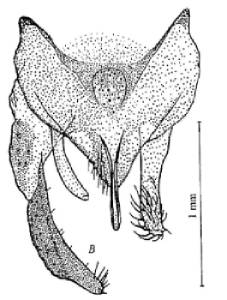Species 3o. C. entis Shobanov, 1989 In BOLD Bin: BOLD:AAB7436
as is Chironomus plumosus.Adult essentially similar to C. plumosus. Shobanov claims differences exist in Palearctic specimens, but these have not been confirmed in the Nearctic. No description of the adults or pupae of the Nearctic specimens appears to have been published, so the data for Palearctic specimens from Shobanov (2005) will be used. Male: Body length generally larger than C. plumosus, but ranges overlap; AR 5.52 (5.09-6.29).
Clypeal setae 75.9 (61-92). Palp segs (3-5) µm: 339 : 375 : 534; P5/P4 1.42, P5/P3 1.42.Thoracic setae: Dorsolaeral 90.3 (77-115); Scutellar 101.4 (79-130).
Selected leg measures (mm) and ratios:
| Fe
| Ti
| Ta1
| LR
| F/T
| Fore
| 2.07-2.34
| 2.30-2.54
| 2.83-3.12
| 1.15-1.31
| 0.90-0.92
| Mid
| 2.41-2.66
| 2.39-2.68
| 1.39-1.59
| 0.58-0.59
| 0.99-1.01
| Hind
| 2.85-3.32
| 3.00-3.45
| 2.05-2.37
| 0.68-0.69
| 0.95-0.96
| About 9-13 setae on TIX, mostly in individual clear spots within an oval area.
Anal point narrow at base and expanding slightly at distal end. Superior volsella possibly closest to E(g) of Strenzke (1959); Inferior volsella relatively long, extending just beyond the end of the anal point and about two thirds of the length of the gonostylus, which narrows relatively sharply over posterior third.
From Shobanov (2005)Female: No information. Immatures Found: British Columbia - Near Opposite Crescent, Bechers Prairie, Cariboo and Chilcotin Parklands (Canning);
Manitoba - Winnipeg (P. Chang); Lake Winnipeg (Sæther 2012).
Ontario - Bay of Quinte, Belleville )(O. Johannsen); White Lake, Three Mile Bay (48.70°N, 85.67°W) (D.R. Oliver);
Quebec - Lake D'Alembert (48.38°N, 79.03°W), Lake Dasserat (48.28°N, 79.42°W), Lake Marlon (48.27°N, 79.07°W),
Lake Opasatica (48.17°N, 79.33°W) and Lake Pelletier (48.22°N, 79.05°W).
Saskatchewan - Lake Waskesiu (53.92°N, 106.08°W), Prince Albert National Park; Crooked Lake (50.60°N, -102.83°W),
Pasqua Lake (50.78°N, -104.00°W), and Round Lake (50.53°N, -102.37°W), Qu'Appelle River (most W. Warwick).
Indiana - Crooked Lake (41.40°N, 85.02°W), Angola Co.; Manitou Lake (41.0353.92°N, 86.1153.92°W), Fulton Co.
Michigan - Saginaw Bay, Lake Michigan (43.45°N, 83.67°W), Bay Co.
Minnesota - Lake Itasca; Lake Christina (46.08°N, 95.75°W), Douglas Co., (46.79°N, 96.28°W) Kiknadze et al. 2000).
North Dakota - Blacktail Dam (48.26°N, 103.44°W), Williams Co.; Brewer Lake (47.25°N, 97.77°W); Fuller Slough
(47.32°N, 97.77°W), and South Golden Lake (47.31°N, 97.50°W), both Steele Co.; Crooked Lake (47.39°N, 100.54°W), McLean Co.;
Dead Colt Creek Dam (46.43°N, 97.68°W), Ransom Co.; McVille Dam (47.77°N, 98.17°W), Nelson Co.; Lake Elsie
(46.04°N, 96.53°W), Richland Co.; Lake Isabel (46.49°N, 99.40°W), and Lake Williams (47.06°N, 90.17°W), both Kidder Co.;
Lake Metigoshe (48.57°N, 100.22°W), Bottineau Co.; Red Willow Lake (47.88°N, 98.40°W), Griggs Co.; Silver Lake
(46.05°N, 97.95°W), Sargent Co.; Warsing Dam (47.83°N, 99.12°W), Eddy Co.; Wilson Dam (47.06°N, 99.40°W), Dickey Co.
Oklahoma - Buncombe Creek, Marshall Co.
South Dakota - Lake Alice (44.53°N, 96.38°W), Deuel Co.
Wisconsin - East Horsehead Lake (45.42°N, 89.37°W), and Pine Lake (45.49°N, 89.55°W), both Onieda Co.; Grand Portage Lake
(46.10°N, 90.80°W), Iron Co.; Green Lake (43.72°N, 89.00°W), and Little Green Lake (43.44°N, 80.59°W), both Green Lake Co.;
Lake Kengonsa (42.977°N, 89.205°W), Dane Co.; Pepin Lake (44.26°N, 92.09°W), Pepin Co.; Pleasant Lake, (42.47°N, 88.33°W),
Walworth Co.; Winnebago Lake 44.01°N, 88.27°W), Calumet Co. (W. Hilsenhoff); Yellow Lake (45.55°N, 92.24°W), Burnett Co. Found in lakes, often with C. plumosus. Kiknadze et al. (1991) describe the outer hooks on the anterior margin of the ventromentum as being longer and sharper than those of C. plumosus in Palearctic populations, but does not seem to apply for North America - besides being very difficult to see. Although the ventral tubules are generally shorter than those of C. plumosus, and where the two species occurred together at Lake Itasca, MN, the two species could be accurately separated on this character, in general there is considerable overlap, and could only be used with confidence if less than 0.4 mm in length. Shobanov (1989b) notes that the basal antennal segment of C. entis (abt 210 µm) is longer than that of C. plumosus (abt 167µm), making the other segments appear relatively shorter than those of C. plumosus (100:18.5:5:7:4 cf. 100:23:7:9:5), while C. vancouveri has relatively shorter segments III, IV and V (100:21:4:6:3).
C. entis and C. plumosus cannot be separated on the basis of the DNA "barcode" sequence of COI, or CytB (Guryev et al. 2001) but can be separated by the sequence of the globin gene gb2Β (Guryev and Blinov 2002). See also C. plumosus, C. balatonicus,C. muratensis, and C. vancouveri[ Return to Index| Go to References ] |
